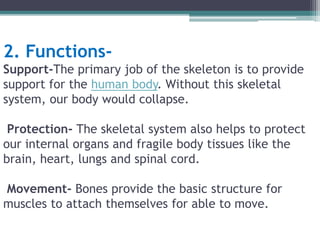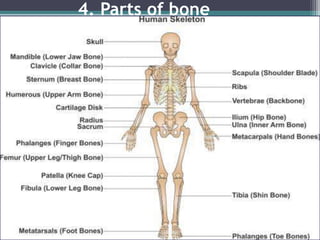Skeletal system
- 1. Skeletal System PRESENTED BY- PRADEEP BANJARE APOLLO COLLEGE OF PHARMACY ANJORA, DURG
- 2. -: CONTENT:- 1. Definition 2. Function of skeletal system 3. Part of skeletal system 4. Part of bones- bone, cartilage, ligament &tendon 5. Cartilage bone 6. Joints bone 7. Tendon & ligaments 8. Difference 9. Some terms 10. total bone in body
- 3. 1. DEFINITION- The adult human skeletal system consists of 206 bones, as well as a network of tendons, ligaments and cartilage that connects them. The skeletal system performs vital functions — support, movement, protection, blood cell production, calcium storage and endocrine regulation that enable us to survive.
- 4. 2. Functions- Support-The primary job of the skeleton is to provide support for the human body. Without this skeletal system, our body would collapse. Protection- The skeletal system also helps to protect our internal organs and fragile body tissues like the brain, heart, lungs and spinal cord. Movement- Bones provide the basic structure for muscles to attach themselves for able to move.
- 7. 4. Parts of bone
- 8. Skull-It supports the structures of the face and provides a protective cavity for the brain. The skull is composed of two parts: the cranium and the mandible. 4.1- SKULL
- 9. Spinal cord consisting-the cervical, the thoracic, and the lumbar spine. (Below the lumbar spine is a bone called the sacrum, which is part of the pelvis). Each section is made up of individual bones, called vertebrae. In which attached skull, ribs, shoulder bone, coller bone, hip bone. 4.2- spinal cord (backbone)
- 10. 4.3- Humerus & radius ulna It attached with clavicle bone & scapula. Also phalanges and metacarpals are attached with carpals joint bone.
- 11. 4.4- Hip bone They attached with lumber bone (part of backbone) in hip bone attached- femur, tibia and fibula, tarsal, metatarsal, and phalanges.
- 12. 5. Cartilage bone Cartilage is a smooth elastic tissue, rubber-like padding that covers and protects the ends of long bones at the joints, rib cage, the ear, the nose, the bronchial tubes, the intervertebral discs, and many other body components.
- 13. 6. Joints hold bone
- 14. 6.1- Types of joints
- 15. 7. tendon & Ligament
- 17. 8.
- 18. 9. Some terms
- 19. 10.




















